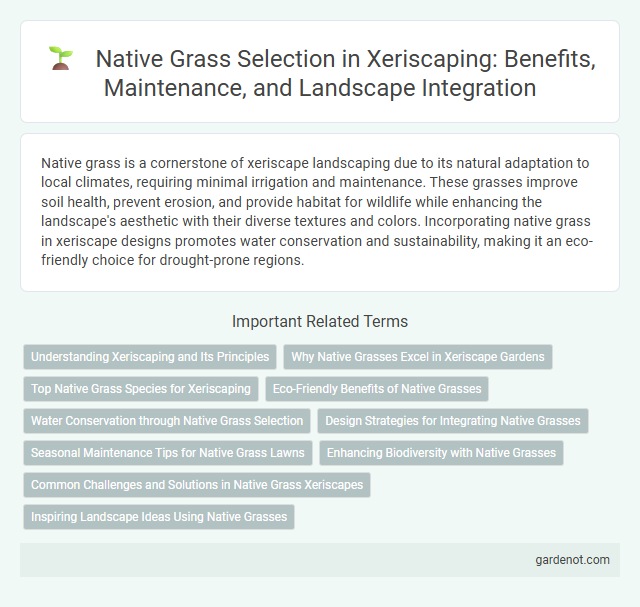Native grass is a cornerstone of xeriscape landscaping due to its natural adaptation to local climates, requiring minimal irrigation and maintenance. These grasses improve soil health, prevent erosion, and provide habitat for wildlife while enhancing the landscape's aesthetic with their diverse textures and colors. Incorporating native grass in xeriscape designs promotes water conservation and sustainability, making it an eco-friendly choice for drought-prone regions.
Understanding Xeriscaping and Its Principles
Native grasses play a crucial role in xeriscaping by requiring minimal water and thriving in local climate conditions, which conserves resources and promotes sustainability. These grasses improve soil health, prevent erosion, and provide habitat for native wildlife, aligning with xeriscaping principles of efficient water use and ecological balance. Selecting drought-tolerant native grasses reduces irrigation needs and maintenance, enhancing the overall resilience of xeriscaped landscapes.
Why Native Grasses Excel in Xeriscape Gardens
Native grasses excel in xeriscape gardens due to their deep root systems that enhance soil stability and improve water infiltration. These grasses are naturally adapted to arid climates, requiring minimal irrigation and thriving with seasonal rainfall. Their drought tolerance and low maintenance needs make them ideal for conserving water while providing aesthetic and ecological benefits.
Top Native Grass Species for Xeriscaping
Top native grass species for xeriscaping include Blue Grama (Bouteloua gracilis), Buffalo Grass (Bouteloua dactyloides), and Little Bluestem (Schizachyrium scoparium), all renowned for their drought tolerance and low water requirements. These grasses enhance soil stabilization, require minimal maintenance, and provide habitat for local wildlife, making them ideal for sustainable landscaping in arid and semi-arid regions. Selecting native grasses like these supports water conservation efforts while maintaining aesthetic appeal and ecosystem health.
Eco-Friendly Benefits of Native Grasses
Native grasses in xeriscape landscaping offer eco-friendly benefits by requiring minimal water and reducing irrigation needs, which conserves water resources. Their deep root systems enhance soil health and prevent erosion, promoting sustainable land management. These grasses also provide habitat for local wildlife, supporting biodiversity and ecological balance.
Water Conservation through Native Grass Selection
Native grass selection plays a crucial role in xeriscape landscaping by significantly enhancing water conservation. Species such as buffalo grass, blue grama, and switchgrass are drought-tolerant and require minimal irrigation, reducing overall water consumption. Incorporating these native grasses not only preserves water resources but also promotes soil health and supports local biodiversity.
Design Strategies for Integrating Native Grasses
Incorporating native grasses in xeriscape design enhances water efficiency by selecting drought-tolerant species such as Blue Grama and Little Bluestem, which adapt well to arid climates. Strategic placement in groupings or as naturalistic borders creates visual texture and erosion control while minimizing irrigation needs. Native grasses also support local biodiversity by providing habitat for pollinators and soil health benefits within sustainable landscape frameworks.
Seasonal Maintenance Tips for Native Grass Lawns
Native grass lawns require seasonal maintenance to promote healthy growth and drought tolerance in xeriscape landscapes. In spring, remove debris and perform light aeration to enhance root development, while summer demands careful monitoring for pests and supplemental watering only during extended dry periods. Fall is ideal for overseeding bare patches and mowing to maintain optimal height, which conserves moisture and reduces weed growth.
Enhancing Biodiversity with Native Grasses
Native grasses play a crucial role in xeriscaping by enhancing biodiversity through providing essential habitat and food sources for local wildlife, including pollinators and soil microorganisms. These grasses improve soil health by preventing erosion and increasing water infiltration, which supports a balanced ecosystem in arid landscapes. Incorporating native grasses into xeriscape designs promotes ecological resilience and sustainability by maintaining regional plant diversity and reducing the need for irrigation and chemical inputs.
Common Challenges and Solutions in Native Grass Xeriscapes
Common challenges in native grass xeriscapes include establishing deep root systems in compacted soils and managing invasive weeds that compete for water and nutrients. Solutions involve preparing soil through aeration and using mulch to retain moisture while applying targeted herbicides or manual weeding to control invasive species effectively. Selecting drought-tolerant native grass varieties such as Buffalo Grass or Blue Grama can enhance resilience and reduce maintenance requirements.
Inspiring Landscape Ideas Using Native Grasses
Native grasses such as Buffalo Grass, Blue Grama, and Little Bluestem offer drought-tolerant landscaping solutions that enhance soil health and promote water conservation in xeriscape designs. These grasses provide year-round visual interest with their varied textures and colors, attracting pollinators and supporting local ecosystems. Incorporating native grasses into xeriscape landscapes reduces irrigation needs and maintenance while creating sustainable, resilient garden spaces.
Native grass Infographic

 gardenot.com
gardenot.com